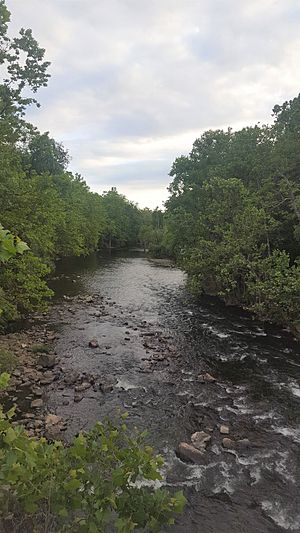Croton River facts for kids
The Croton River (pronounced KROH-tən) is an important river in southern New York. It has three main parts: the West Branch, Middle Branch, and East Branch. All of these branches help supply water to New York City.

The water from these branches joins together below the Croton Falls Reservoir. This river system, along with its reservoirs, makes up the northern part of New York City's water supply. This whole area is called the Croton Watershed.
After the three branches meet, the Croton River flows into the Muscoot Reservoir. It then goes into the New Croton Reservoir. This reservoir feeds the New Croton Aqueduct, which carries water to New York City. Any extra water flows over the New Croton Dam and into the Hudson River. This happens near Croton-on-Hudson, New York at Croton Point. This spot is about 30 miles (48 kilometers) north of New York City. The river and its connected streams drain an area of about 361 square miles (935 square kilometers).
Contents
The Croton River's Role in New York City's Water
The Croton River has played a big part in providing water for New York City for a long time.
Early Water Supply: The Old Croton Aqueduct
Starting in 1842, the Croton River became the main source of drinking water for New York City. The water traveled to the city through a special channel called the Croton Aqueduct. This channel is now known as the Old Croton Aqueduct.
Building the New Croton Dam and Reservoirs
As New York City grew, it needed even more water. In 1884, engineers started designing a huge dam across the Croton River. This dam would be between 275 and 300 feet (84 to 91 meters) tall. It was built near where the river meets the Hudson.

This new dam created a large storage area for water, covering about 16 square miles (41 square kilometers). It could hold a massive 14.2 billion US gallons (53.7 million cubic meters) of water. This dam, now called the New Croton Dam, was finished in 1906.
Further upstream, two of the Croton River's branches were also dammed. This created the Croton Falls Reservoir, which began supplying water in 1911.
Keeping the Water Clean
In the 1890s, New York City wanted to make sure its water stayed clean. Instead of building expensive filters, the city decided to move or remove any small towns or villages that might make the river water dirty. Many of these communities were relocated.

Modern Water Treatment
By the late 1990s, the water from the Croton River was becoming less suitable for drinking directly. Because of this, New York City stopped using it for a while. In 2004, a big project began to fix up the New Croton Aqueduct. This project also included building a special plant to filter the water. This filtration plant was expected to start working after 2015.

